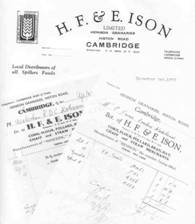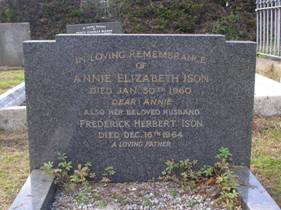Frederick Herbert Ison 1894–1964
In the 1890s Herbert Ison lived in a cottage at 140 Histon Road. He acquired a horse and cart and started a small business purchasing ‘offal’ (in milling a term for bran, pollard etc: the ‘waste’ from the milling process, used as animal food) from the French’s windmill and travelling around the local villages to sell it. He operated from the stables adjoining Scales’ Hotel (now the site of the Portland Arms) at the junction of Milton and Chesterton Roads.
Herbert’s family included three sons: Frederick Hebert b.1894, Ernest J b. 1899 and William Frank b.1900.
After service in the Great War, Herbert returned and the business continued with the involvement of the sons. In 1925/6 Herbert acquired the site opposite his home on Histon Road (now a tyre company) and built a granary to store the grain and products he was buying and selling.
The business was called ‘Henison Granaries’ the ‘Hen’ part signifying their large trade in poultry food. ‘Henison’ was the name of ‘the complete laying meal’, their own brand of poultry feed. They traded as H. F. & E. Ison, the H being Herbert, the F being Frederick and Frank and the E being Ernest.


The business flourished in the period 1930-1950, by when a fleet of 18 vehicles was operating. A lorry would go daily to the large mills at London Docks (Rank, Spillers, BOCM) with grain from local farmers and return with flour and prepared animal feed. Regular trips were also made to Grimsby for fish meal and Wells-next-the-Sea for cockle shells. Mr W.F.A. Ison remembers driving a laden lorry and trailer to the London docks when he was 13. Limited to 20mph the lack of traffic meant this journey was quicker than today!! Regulation was soon to govern the use of vehicles.
After the Second War, a shop was opened at the entrance to the granary site selling small quantities of animal feed, straw etc to local people.
By the 1960s the pattern of business was changing: farms were dealing directly with the large milling companies, both to sell their grain and to purchase animal feed. Frederick Herbert Ison died in 1964 and is buried in Histon Road Cemetery. The business continued under the control of his son W.F.A. Ison and his sister but circumstances made the business no longer viable and it closed in 1968, the site being sold to become a tyre depot.
Sources:
Conversation with Mr W F A (Bill) Ison August 2008

